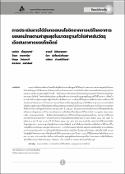บทคัดย่อ
กรดเบนโซอิกและเกลือเบนโซเอตเป็นวัตถุเจือปนอาหารที่อนุญาตให้ใช้ตามประกาศกระทรวงสาธารณสุขฉบับที่ 281 ปริมาณที่อนุญาตให้ใช้กรดเบนโซอิกและเกลือเบนโซเอตตามประกาศฉบับนี้ควรมีความสอดคล้องกับมาตรฐานสากลและสามารถคุ้มครองสุขภาพผู้บริโภคได้ จึงต้องทบทวนข้อกำหนดให้สอดรับกับมาตรฐานทั่วไปสำหรับวัตถุเจือปนอาหารของโคเด็กซ์ โดยนำหลักประเมินความเสี่ยงมาพิจารณากำหนดปริมาณสูงสุดที่อนุญาตให้ใช้ในอาหาร เพื่อสร้างความมั่นใจในการคุ้มครองสุขภาพผู้บริโภคในระดับที่เหมาะสม การศึกษานี้มีวัตถุประสงค์เพื่อประเมินความเสี่ยงการได้รับกรดเบนโซอิกจากการบริโภคอาหารของคนไทยตามปริมาณสูงสุดที่อนุญาตให้ใช้ในมาตรฐานอาหารของโคเด็กซ์ โดยประมาณปริมาณการได้รับสัมผัสจากปริมาณสูงสุดของกรดเบนโซอิกในอาหารกับปริมาณการบริโภคอาหารรายบุคคล ที่ได้จากการสำรวจข้อมูลบริโภคอาหารของประเทศ ปี 2547 ประมาณความน่าจะเป็นของการได้รับสัมผัสที่ระดับเฉลี่ยและระดับสูงของการบริโภค แสดงลักษณะความเสี่ยงโดยเปรียบเทียบการได้รับสารกับค่า Acceptable Daily Intake (ADI) ของกรดเบนโซอิก ซึ่งเป็นระดับปลอดภัยในการได้รับสารนั้นของมนุษย์ตลอดชั่วอายุ พบว่าการได้รับกรดเบนโซอิกของประชากรไทย จากการบริโภคอาหารทั้งหมดที่ระดับเฉลี่ยมีค่าสูงกว่า ADI (ร้อยละ 124 ของ ADI) ในกลุ่มอายุ 3-5.9 ปี และ 6-18.9 ปี มีค่าร้อยละ 224 และ 150 ของ ADI ตามลำดับ แสดงว่าหากใช้กรดเบนโซอิกในทุกกลุ่มอาหาร ตามมาตรฐานวัตถุเจือปนอาหารของโคเด็กซ์ จะทำให้เด็กและวัยรุ่นมีความเสี่ยงในการได้รับสารนี้ในระดับที่มีโอกาสก่ออันตรายต่อสุขภาพในระยะยาว การได้รับกรดเบนโซอิกปริมาณสูงอย่างต่อเนื่องเป็นเวลานานมีผลต่อการทำงานของตับและไต การบริโภคเครื่องดื่มประเภทน้ำหวานอัดก๊าซ ที่ระดับการบริโภคสูง (เปอร์เซ็นไทล์ที่ 97.5) ในกลุ่มผู้บริโภคอาหารรายการนี้เท่านั้นจะทำให้ประชากรอายุ 3-5.9 ปี และ 6-18.9 ปีได้รับกรดเบนโซอิกร้อยละ 144 และ 96 ของ ADI ตามลำดับ ดังนั้นควรปรับลดปริมาณสูงสุดที่เสนอในมาตรฐานนี้ลง ในหมวดอาหารที่ทำให้เด็กและวัยรุ่นได้รับกรดเบนโซอิกปริมาณสูง โดยเฉพาะ น้ำหวานอัดก๊าซ ขนมอบ ผักและผลไม้แปรรูป
บทคัดย่อ
The use of benzoic acid and benzoates, food additives, are endorsed by the Notification of the
Ministry of Public Health No. 281. The permitted levels of benzoic acid and benzoates established in the
Notification should conform to international standards and protect consumer health. It needed to revise
the regulation according to the Codex General Standard for Food Additives (GSFA). Risk assessment tools
was employed for establishment of the maximum permitted use levels (MLs) to ensure consumers will
obtain appropriate level of health protection from over-consumption of benzoic acid. This study aimed to
assess the risk of dietary benzoic acid exposure in Thai population based on the MLs proposed in the
Codex food standard. The exposure was estimated by combining the MLs of benzoic acid in foods with
individual food consumption data received from the national food consumption surveys in 2004.
Probabilistic estimation was used to assess the exposure to benzoic acid at average and high consumption
levels. Risk was characterized by comparing the exposure with the Acceptable Daily Intake (ADI) of benzoic
acid. ADI is a safe level for human exposure to the chemical over a lifetime. The study found that the
average benzoic acid exposure in Thai population exceeded the ADI (126% of ADI). The population aged
3-5.9 years and 6-18.9 years had average exposures at 226 and 153% of ADI, respectively. This indicated
that there was an appreciable health risk for children and adolescences at long term exposure when using
benzoic acid in all food groups according to the GSFA. Long term exposure to high level of benzoic acid
can effect on liver and kidney functions. High consumption of carbonated water-based flavored drinks at
97.5th percentile in population aged 3-5.9 years and 6-18.9 years provided high exposure at 144 and 96 %
of ADI, respectively. Thus, the MLs of benzoic acid proposed in this standard should be reduced in food
categories contributed high benzoic acid exposure in children and adolescences especially carbonated
water-based flavored drinks, bakery wares, processed fruits and vegetables.


